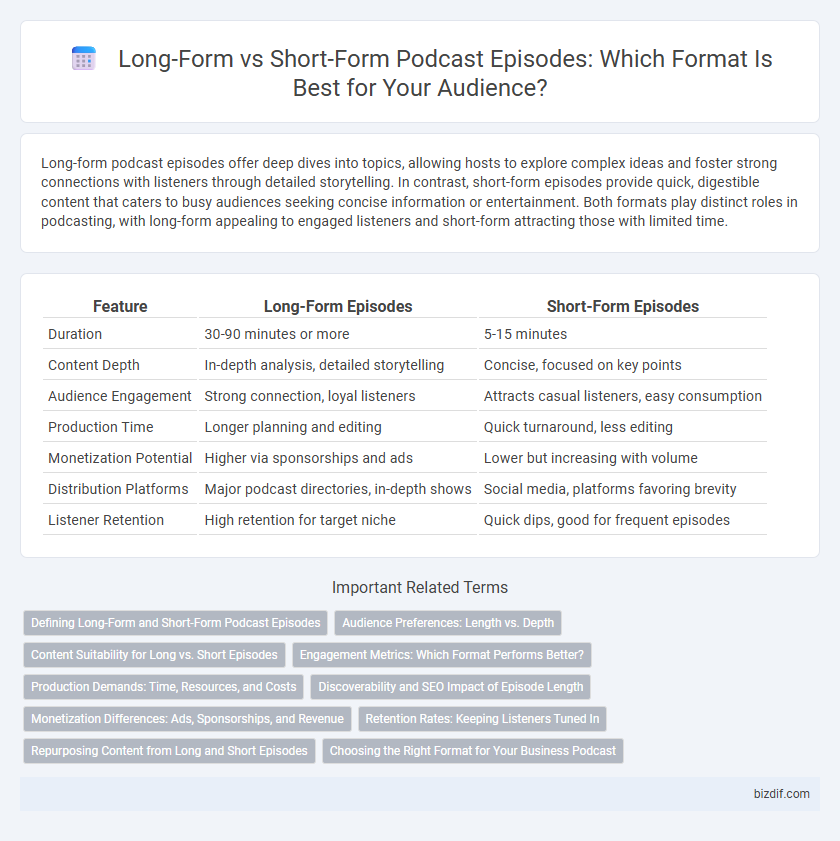Long-form podcast episodes offer deep dives into topics, allowing hosts to explore complex ideas and foster strong connections with listeners through detailed storytelling. In contrast, short-form episodes provide quick, digestible content that caters to busy audiences seeking concise information or entertainment. Both formats play distinct roles in podcasting, with long-form appealing to engaged listeners and short-form attracting those with limited time.
Table of Comparison
| Feature | Long-Form Episodes | Short-Form Episodes |
|---|---|---|
| Duration | 30-90 minutes or more | 5-15 minutes |
| Content Depth | In-depth analysis, detailed storytelling | Concise, focused on key points |
| Audience Engagement | Strong connection, loyal listeners | Attracts casual listeners, easy consumption |
| Production Time | Longer planning and editing | Quick turnaround, less editing |
| Monetization Potential | Higher via sponsorships and ads | Lower but increasing with volume |
| Distribution Platforms | Major podcast directories, in-depth shows | Social media, platforms favoring brevity |
| Listener Retention | High retention for target niche | Quick dips, good for frequent episodes |
Defining Long-Form and Short-Form Podcast Episodes
Long-form podcast episodes typically run over 30 minutes, often reaching an hour or more, allowing for in-depth discussions, detailed storytelling, and comprehensive interviews. Short-form episodes usually last under 15 minutes, offering concise, focused content ideal for quick listening and high audience retention. Defining long-form and short-form formats helps podcasters tailor content to audience preferences and maximize engagement across different listening habits.
Audience Preferences: Length vs. Depth
Long-form podcast episodes, typically exceeding 45 minutes, appeal to audiences seeking in-depth discussions and comprehensive exploration of topics, enhancing listener engagement through detailed storytelling and expert insights. Short-form episodes, often under 15 minutes, cater to listeners with limited time who prefer concise, focused content that delivers value quickly and maintains high retention rates. Audience preferences vary based on lifestyle and content goals, making it essential for podcasters to balance episode length with the depth of information to maximize reach and satisfaction.
Content Suitability for Long vs. Short Episodes
Long-form podcast episodes excel at in-depth storytelling, detailed interviews, and comprehensive discussions that require time to explore complex topics fully. Short-form episodes are ideal for quick updates, concise tips, or focused insights, catering to listeners with limited time who prefer brief, impactful content. Choosing between long and short formats depends on audience preferences, content complexity, and the desired level of engagement.
Engagement Metrics: Which Format Performs Better?
Long-form podcast episodes typically generate higher listener retention rates and deeper audience engagement as they allow for comprehensive storytelling and in-depth discussions. Short-form episodes often achieve increased download numbers and appeal to time-constrained listeners, boosting overall reach. Engagement metrics reveal that while long-form content excels in maintaining listener attention, short-form episodes drive more frequent consumption and broader discoverability.
Production Demands: Time, Resources, and Costs
Long-form podcast episodes require greater time investment for scripting, recording, and editing, often demanding more advanced equipment and skilled personnel, which increases production costs significantly. Short-form episodes, by contrast, streamline production with quicker turnaround times and lower resource requirements, making them more cost-effective for smaller teams or solo creators. Balancing these factors is crucial for podcasters aiming to optimize workflow efficiency without compromising content quality.
Discoverability and SEO Impact of Episode Length
Long-form podcast episodes typically enhance discoverability by providing in-depth content that keeps listeners engaged, increasing average listen duration and boosting search engine rankings. Short-form episodes benefit SEO by allowing frequent releases and targeting niche keywords, driving consistent audience growth and higher episodic visibility. Balancing episode length according to audience preferences and keyword strategies maximizes SEO impact and discoverability across platforms.
Monetization Differences: Ads, Sponsorships, and Revenue
Long-form podcast episodes often generate higher ad revenue due to extended listener engagement and more ad slots, attracting premium sponsorships and branded partnerships. Short-form episodes capitalize on frequent publishing, boosting total ad impressions and appealing to advertisers seeking quick, targeted messages. Monetization strategies vary by episode length, with long-form prioritizing in-depth sponsorship deals and short-form leveraging volume and listener frequency for steady revenue streams.
Retention Rates: Keeping Listeners Tuned In
Long-form podcast episodes generally achieve higher retention rates by fostering deeper engagement and building stronger listener loyalty through in-depth storytelling and detailed discussions. Short-form episodes attract listeners with their concise content, but often face challenges maintaining sustained attention beyond initial minutes. Data from podcast analytics platforms indicate that episodes lasting 20 to 40 minutes consistently outperform shorter segments in listener completion rates, highlighting the importance of content depth for retention.
Repurposing Content from Long and Short Episodes
Long-form podcast episodes provide in-depth content ideal for repurposing into multiple short-form snippets, maximizing audience reach across social media platforms. Short-form episodes distill key insights, making them perfect for quick shares and teasers that drive listeners to full-length shows. Combining both formats enhances content versatility and boosts engagement by appealing to diverse listener preferences.
Choosing the Right Format for Your Business Podcast
Long-form podcast episodes, typically exceeding 30 minutes, enhance in-depth storytelling and detailed discussions, making them ideal for businesses aiming to showcase expertise and build strong listener relationships. Short-form episodes, ranging from 5 to 15 minutes, cater to busy audiences seeking concise, actionable insights, boosting engagement and shareability on social media. Selecting the right format depends on your target audience's preferences, content complexity, and marketing goals, ensuring alignment with your brand's communication strategy.
Long-form episodes vs short-form episodes Infographic

 bizdif.com
bizdif.com